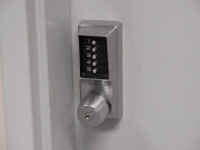Robbery Prevention Tips
Because of several robbery prevention studies conducted by both private companies and governmental agencies, we now have a better understanding of how criminals choose their targets. According to most of these studies, the top deterrents to robbery are:- Clear windows to increase visibility from the street. When
passers-by can see what is happening inside, there is a greater
risk to the robber.
- Good lighting of all areas of the parking lot and around the
building. This will eliminate places where people can hide and
will permit others to "see what's happening."
- Use of a drop-safe so that there is never more than $50 cash
in the drawer. Drop safes don't have to be large or expensive
and are easy to install.
- Posted signs about low cash on hand. Let the criminals know
that they won't get much and it's not worth the risk!
- Trained employees on prevention and response procedures.
Establish a robbery prevention checklist and include regular
training for all staff members. Include directions to cooperate
(do not resist) with any person who threatens personal harm.
- A surveillance camera that is visible in the
reception/waiting area.
- Controlled access for the public
with automatically locking doors. Simply using "one-way" doors
between the reception/waiting room and the rest of the hospital
can give the staff extra time to summon help if someone becomes
hostile or threatening.

- Making sure the "employee entrance" door is locked at all
times. Many practices have found that installing a "keyless"
entry system like the one pictured here not only alleviates the
locked door problem, but also makes it easy when staff members
leave - you don't have to change locks; you just change the
combination.
Click here to view our "Suggested Sources Sheet" for keyless
locks.
- Use of an electronic alarm system with a "panic button"
feature to summon assistance quickly. Most alarm monitoring
companies provide continual protection for a very modest fee.
- Removal of cash from the drawer at night and leaving the
drawer open.
- Counting cash away from front desk and windows.
- Specific security issues when employees must work alone.
According to every study thus far, businesses with a single
employee on duty were most at risk of robbery. Establish
"accountability" routines when a staff member has to go to the
practice for emergencies or other business during
non-operational hours.
- Installation of peep holes or small windows in exterior
doors so that the staff can see outside before opening the door.
- Storage of money (including checks and credit card slips) in
a secure safe awaiting deposits. Deposits should be made daily
to keep the amount of monies on hand to the minimum necessary
for operations.
- No one action alone will deter
crime, but by combining all of these elements into a prevention
program, the business becomes a less inviting target for the
planned crime.
Perhaps the best way to "crime-proof" the practice is to consult the local police. Most police departments have a crime prevention unit with the sole purpose of providing advice about security, crime prevention and personal safety. The best part of that service is that it's usually free!
Did You Know...?
The average armed robbery lasts less than 2 minutes.
Here's a neat brochure to use in your next staff meeting when discussing security and violence prevention issues. It's produced by the Henry County Georgia Police Department but it's advice is good everywhere!
http://co.henry.ga.us/Police/pdf/RobberyBrochure2015.pdf
